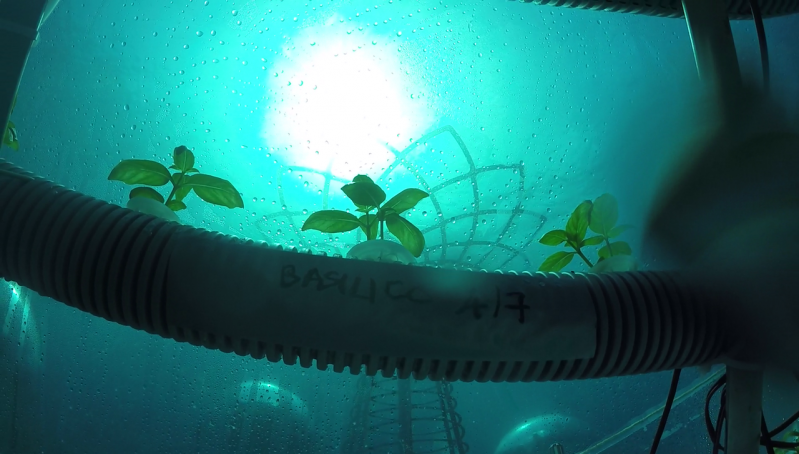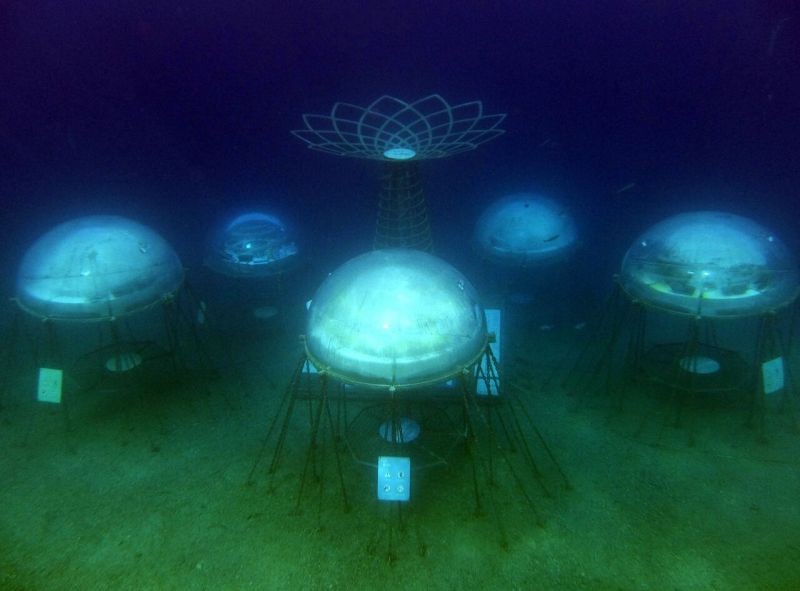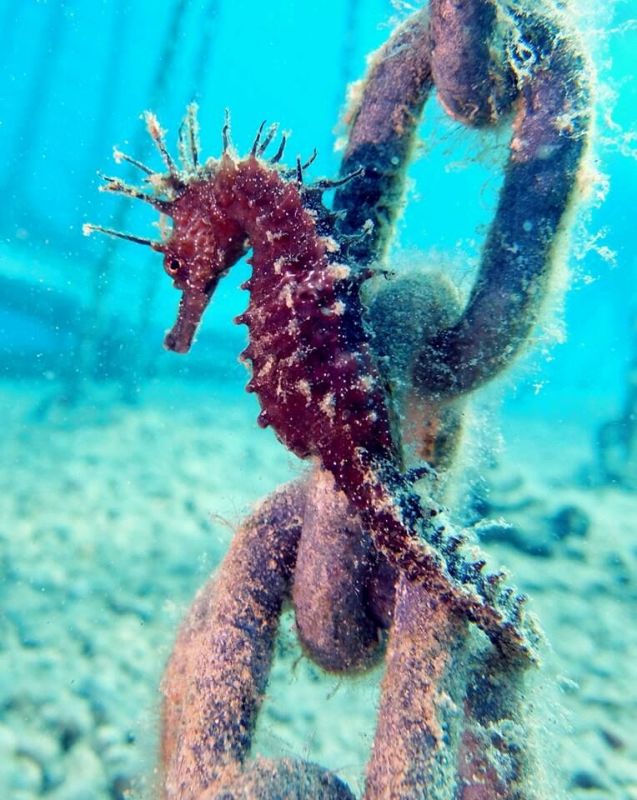Underwater Conversation with Sergio and Luca Gamberini from the Ocean Reef Group
Published on by Water Network Research, Official research team of The Water Network in Technology
The Water Network interview with Sergio Gamberini, President of the Ocean Reef Group and Luca Gamberini, Marketing Manager at the Ocean Reef Group.
5 years ago Sergio Gamberini was enjoying his summer vacation in Noli, Italy. Scuba diving has always been not only a business related activity, but a passion and a hobby deeply rooted inside him.
With the help of his team at Ocean Reef Group, he started building a number of small transparent balloons – then, they sunk them and filled them with air while underwater, they anchored them and ultimately, planted seeds in a vase inside!
The idea he had was to utilize the properties of the large bodies of water – constant temperature, united with the natural evaporation of a surface of liquid in contact with an air space – to try creating an underwater greenhouse!
 Q1: How are plants grown in the underwater garden? Are there plants which are more convenient for underwater growth and to which plant stage can they remain in the garden?
Q1: How are plants grown in the underwater garden? Are there plants which are more convenient for underwater growth and to which plant stage can they remain in the garden?
Plants are presently grown in hydroponics systems and sterile, ecological substrates in vases. The latter are to increment the yield. The first are the “actual thing”.
We have a spiral along which there are 60 pods that hold coconut fiber cones – on these cones we place seeds. The cones gather water from the tube and the humidity makes the seeds sprout.
Once they grow, the plant’s roots reach in the water and gather nutrients. Water is pumped up to the top of the spiral, then flows down to a container where the pump feeds off of. This is timed, or actioned remotely. It’s a known way to grow plants maximising resources and reducing waste.
Almost all plants we planted had a pretty good run. We noticed a very, very, very fast initial phase. The rest of the life of the plant is, of course, unknown to us in detail – we are not farmers and don’t necessarily know how to further increment the yield.
I am very positive that, if we were to have that knowledge we could really boost our yields. It would be hard for us to pinpoint exact species of plants with a better suiting of the environment - it is kind of like a small world so it is very complicated.
I’m sure that with the correct botanical knowledge, we could improve the growth of any plant that we tested. Deciding depth, illuminance, even gas concentration, according to plant and will of the farmer, would be crucial. We just applied our common sense and knowledge and received great results nonetheless! So this is encouraging, knowing there is still so much we can improve.
Basil, tomatoes, aloe, beans, tagete.. so many have work excellent the only limitation is space. There is no specific phase of the plant’s life that requires the transplant outside. Not that we have found yet anyway. there is a partial list of what plants we experimented on our website.
Q2: Being underwater, the plants are obviously protected from pests, but how do they get nutrients and light?
Nutrients are dissolved in the water from our Argonauts – or scuba diver farmers, of the team. We use an eco-friendly fertilizer. In the near future, we will experiment with fertilizers created on site – we have installed an invertebrates forest, this forest is made up of various types of invertebrates whom, we will grow to use as nutrient for the plants. If this works we will effectively close the loop of resources.
First of all, not all plants require the same amount of light. Red-leafed plants, for example, require a lot less. We get already enough light at our depth for green plants. If we were to exploit some other specs of the vertical water column, we could, for example, decide to go deeper and use less-light based plants.
Finally – light is not an issue. We also have a remotely operated lighting system, in case we need more light. or more hours of illuminance.
Q3: Why do plants grow faster in the spheres and what other benefits does this technology bring?
Apparently, the increased pressure renders the plants more permeable to gases. it’s kind of like Hyperbaric oxygen treatments – the increased exchange in gases, and probably also the original conditions, seem to really give a boost to the plants that sprout and grow, extremely fast. The benefit of quicker yields is obvious. Other benefits seem to be, from our analysis, that the plants born underwater have a richer content in essential oils. so, they apparently are better than their relatives above water. kind of like they were “compressed”. A gr of underwater basil is more potent than one gr of above water basil…!

Q4: Could you please elaborate on the role of water temperature on the plants and fresh water production? Is that amount for water enough for watering the plants?
The heat capacity of water is much higher than that of air. Which means that water will retain heat longer. This guarantees us a very stable temperature and a mild temperature also while temperatures outside go to extremes which are not beneficial for plants.
Freshwater production is correlated to temperature, but it is actually a different thing. What happens is that the surface of salt water inside the biosphere, will evaporate (just like sea, oceans, lakes, glasses of water on the table do) naturally. When evaporating, it lets go of its content in salt and minerals (becomes fresh distilled water – like rain). Once it “hits” the colder dome, it will condense, then drip down to where we collect it.
The amount of water to collect is noteworthy and not simple to calculate in a dynamic system. It sounds simple but it really is not. We are trying to get the most out of it. most of our needs are from the natural evaporation, yes. There is still a lot of development to do, but I think we are on the right track. I think we will be able to reach 100%, and we are confident that we will even find a way to have extra to store, and maybe take out. Anyway, the concept stands and is what we are pursuing. We want it to be automatic and easily manageable in any condition, anywhere.
Q5: Tell us something about the technology itself - about the spheres, the Tree of Life, monitoring the plants and communication between the spheres and the Control Tower.
The tree of life is a splendid memento of our experience at Expo Milan 2015. We were honored to be selected to represent our region and country as an excellence and possibility for the future. During the venue, we fell in love with Marco Balich’s design of the Tree of Life, which was an inspiration from Singapore’s Garden and, originally, Michelangelo’s design. We wanted to have a central element for the project site. Something that would be also amusing for visitors. The tree itself is not only beautiful – it also serves the purpose of concealing the central cabling system.
Each biosphere is equipped with a tech box. Each tech box has a wi-fi connection and a bunch of sensors. What we can do is remotely operate: lights, fans, pumps. From a phone, while in an airport in Malaysia. We have oxygen and CO2 sensors – which of course are imperative for a safe working environment, but also can help us understand what the plants need and what might be increased to improve yields. We have humidity sensors, light sensors, temperature sensors – all the data is very useful for our research.
Thanks to the internet connection, underwater, we can live chat with anyone anywhere. This is of course fun and cool, but it also helps a lot during set up to guide who is working underwater and troubleshoot the bios on any other given day. All data is streamed live on our website. Researchers, or simple fans, can all contribute to the research by following the trends and the underwater cameras (we have those as well).
We can speak via intercom with the control tower, live, from underwater. When we are in the water, we have special underwater comm units to coordinate with each other. Thanks to this technology, Nemo’s is a modern greenhouse.

Q6: Do you believe Nemo’s Garden is a sustainable solution for the world’s rising food problem? The spheres would solve the problem of lack of land, but what about costs and manual labor?
I sincerely believe that yes, it Is a feasible alternative. Logic tells us that there is an evident possibility. But is it economically sustainable? I believe that 5 years down the road – with just our ideas and manpower and our private investment – what we were able to achieve is already incredible. So, if this is true, it is easily imaginable that the project could be scalable and engineered on an industrial scale. At that point, the cost will be driven down because we will have maximized the yields and reduced the cost.
I doubt that the first greenhouses could compete against the cost of standard agriculture, but, in time, they acquired the upper hand.
Same thing can be said for this technology for the future. Especially if we think about how conditions for standard agriculture will deteriorate in the future.
Maybe the best comparison / metaphor, could be done with oil and carbon fuels. Electric and renewable energies were, and to some extent still are a lot less convenient than oil and carbon, if you look at the problem only from a cost point of view – and still have also some practical disadvantages too (mileage, standard..) BUT nobody would say, now, in 2017, that green energy and electric cars are a fraud. At least nobody who knows what she/he is talking about. It just requires investment in time and R&D.
Q7: How scalable is this technology?
We don’t know the limit yet. We have many different biosphere designs – some that are unmanned. The whole technology pack is not necessary when you want to concentrate on intensive cultures. The pods could be multiplied in number, or volume. It all depends on what you want to obtain and the what the conditions require. Again – we have had quite successful yields. but none of us are biologists, agronomists etc.… IF we were, then we could seriously increment our yields! So, to answer the question, I think it is scalable as other common methods of agriculture are.
Plus, our aim is to develop Nemo’s to partner up with artificial reefs, coral restorations, clam farming, fish farming – we could mutually benefit by integrating these technologies.
 Q8: Do the spheres have influence on the marine ecology?
Q8: Do the spheres have influence on the marine ecology?
Yes, they do. A very positive influence, in our experience. As you know, anything you put in the ocean, will crawl with life in just a matter of days. Nemo’s is no different. We have seahorses taking shelter and giving birth along our chains. We have small fish taking shelter under the domes – attracting the whole food chain.
We have an incredible number of animals that just live in the proximity. They don’t perceive the domes as menacing, so, since they are big and static, they are associated to reefs, or rock hideouts. It is our responsibility to reduce to zero our impact on the local life. As of now, I am pretty sure we have contributed positively to the increase of biodiversity.
Q9: What are the future plans for Nemo’s Garden and Ocean Reef Group?
Our plan is to continue with our experiments and to find the correct investors and partners for this project. We will bring Nemo’s to its full potential, whatever that is.
On a timeline, 2017 is year 0 in a certain way, because we enter summer with plenty of new innovations in the biospheres AND we get ready for a full winter season. Last year’s winter was the first – and very exciting – but we had to leave only 2 biospheres.
This year we plan on leaving anything we can in place and proceed through the winter to test the durability of our equipment and the response from the plants. Also, we are going to install 2 biospheres in other locations – this is even more important as we will understand how to manage delocalized realities, how different places interact with the structures and how much we need to modify our way of working and adapt the project. It’s going to be wildly interesting.
Q10: Finally, do you have a take-home message for TWN’s ‘ aquapreneurs ’?
We are very earthly people. We didn’t expect so much from what we invented. We just followed one idea after another, working as a team. No Einstein genius and no rocket science - technology or investment.
Normal people doing extraordinary things thanks to a lot of heart and belief in what we are doing, and a lot of commitment and abnegation.
I know it’s a fairly common take, but it is true – when you have an idea, you got to do all you can to pursue it.
The future is in the Oceans. As an environment, but also for the resources that it has to offer – and maybe, also for activities that were commonly associated with land environments.
We know that the world still has a lot to offer, but we have to stop and think about how we can use the resources in a responsible way, in a better way.
Read More Interviews from the 'In Conversation With' Series
by The Water Network
Attached link
http://www.youtube.com/embed/fGF9ZSwo6u8Media
Taxonomy
- Agriculture
- Hydroponics
- Sustainable Agriculture
- Agriculture
- Sustainable Agriculture
- Agriculture
- Agriculture
1 Comment
-
Need SWC micro bubble.